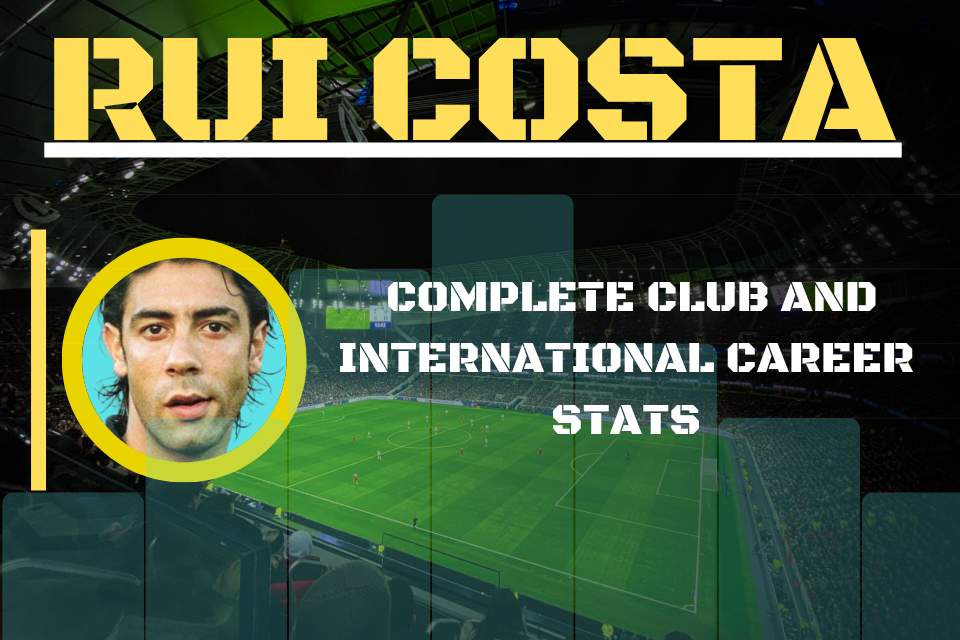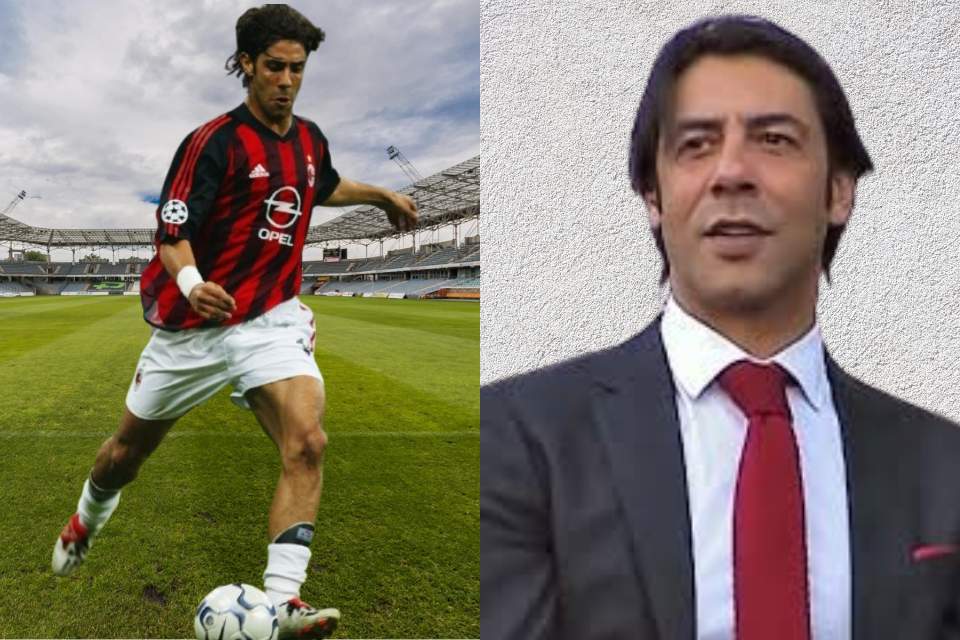In an era when raw power often dominated the beautiful game, Rui Costa footballer emerged as a true icon of sophistication, creativity, and tactical brilliance. Widely regarded as one of the most elegant midfielders in football history, his impact went far beyond Portugal, resonating deeply with fans across the European continent.
His dazzling displays for clubs like Benfica, Fiorentina, and AC Milan cemented his reputation as a masterful playmaker especially adored by supporters in Italy, Portugal, Spain, and beyond. For many in Europe, Rui Costa wasn’t just a footballer, he was an artist who transformed the midfield into a canvas of vision, control, and poetic passing.
Let’s explore the remarkable journey and lasting legacy of this legendary Portuguese midfielder who helped shape modern European football.
Early Life and Football Beginnings
Born on March 29, 1972, in Amadora, Portugal, Rui Manuel Cesar Costa showcased his footballing talents from a very young age. At just 5 years old, he caught the eye of the legendary Eusebio, who declared him a star in the making. By the age of 9, Rui Costa had joined the Benfica youth academy, one of Portugal’s most prestigious football institutions.
His passion for the game was visible in every touch. With supportive parents, Vitor and Manuela Costa, and a relentless drive, Rui Costa quickly climbed the ranks of Portuguese youth football.
Rise at Benfica – Building the Foundation
After years of development, Rui Costa made his professional debut for Benfica in the early 1990s. He was briefly loaned to Fafe, a Portuguese second division team, where he gained valuable experience and confidence. Upon returning to Benfica, he broke into the first team during the 1991–92 season.
Over the next few seasons, Rui Costa played a vital role in Benfica midfield. His vision, playmaking abilities, and calm demeanor under pressure made him the beating heart of the squad. He helped Benfica win the Primeira Divisao (Portuguese League) title in 1993–94, catching the attention of top clubs across Europe.
The Italian Adventure: Fiorentina & AC Milan
Fiorentina Era (1994–2001), In 1994, Rui Costa transferred to Fiorentina, a club based in Florence, Italy. Here, he formed a legendary partnership with Argentine striker Gabriel Batistuta. Rui Costa creativity behind Batistuta ruthless finishing became the stuff of legend.
Rui Costa spent seven unforgettable seasons at Fiorentina, where he earned immense respect and unwavering affection from the club’s fans. He led the team to Coppa Italia glory in 1995–96 and helped the club qualify for the UEFA Champions League. Though Fiorentina never won the Serie A title, Rui Costa performances made him one of the most respected midfielders in Italy.
His style was so admired that Italian fans began calling him “Il Maestro” (The Master) a fitting tribute to his artistic approach to football.
Read Also:- Most Underrated Footballers of the 21st Century
AC Milan Glory Days (2001–2006)
In 2001, Rui Costa made a high profile move to AC Milan for a reported fee of €41 million one of the most expensive transfers at the time. Joining a star-studded squad with Paolo Maldini, Clarence Seedorf, and Andriy Shevchenko, Rui Costa flourished under coach Carlo Ancelotti.
He played a crucial role in AC Milan 2002–03 UEFA Champions League campaign, helping them win the title after defeating Juventus in a dramatic final. The following year, they clinched the Serie A title.
Though competition for places increased with the arrival of Kaka, Rui Costa remained a vital team player contributing with maturity, experience, and unmatched footballing intelligence.
Return to Benfica and Retirement
In 2006, Rui Costa came back to Benfica, the club closest to his heart, marking the final chapter of his football career. Although his physical abilities had waned, his football brain and leadership were as sharp as ever. Over two seasons, he mentored young players and reminded fans of his magical touch.
He said goodbye to professional football in 2008, aged 36, during a farewell game that brought tears to the eyes of many Benfica fans.
Rui Costa Complete Club and International Career Stats
Rui Costa built a remarkable career, competing at the highest level in club football across Portugal and Italy, and contributing greatly to the Portugal national side.

He began his senior career at Benfica in 1991, where he quickly made his mark. During his first spell with the club (1991–1994), he made 78 appearances and scored 13 goals, becoming a vital part of their midfield lineup.
In 1994, Rui Costa moved to Fiorentina in Italy Serie A. Over seven seasons with the club (1994–2001), he appeared in 276 matches, netting 50 goals and establishing himself as one of Europe most creative and elegant midfielders.
Following his impressive run in Florence, he joined AC Milan in 2001. From 2001 to 2006, he played 192 games for the Rossoneri, scoring 11 goals, and was instrumental in helping the team win major titles, including the UEFA Champions League and Serie A.
From 2006 to 2008, he added 54 appearances and 12 goals to his name before retiring from professional football.
Across his entire club career, Rui Costa made over 600 appearances and scored more than 86 goals, while also delivering countless assists and creating game defining plays.
On the international stage, Rui Costa proudly represented Portugal from 1993 to 2004. During that time, he earned 94 caps and scored 26 goals, participating in several major tournaments, including UEFA Euro 1996, Euro 2000, Euro 2004, and the 2002 FIFA World Cup.
UEFA Euro 2000 – Semi-finalists; one of his best tournaments.
Read Also:- Biography of Lamine Yamal: The rising star of Spanish football
Style of Play – The Definition of Elegance
Rui Costa was not just a footballer, he was a composer orchestrating every move on the pitch. He primarily played as an attacking midfielder, known for:
- Pinpoint passing
- Exceptional vision
- Ball control under pressure
- Accurate long shots
- Tactical intelligence
In an era dominated by physicality, Rui Costa cerebral approach reminded fans that football is as much an art as it is a sport.
Life After Football – Leadership at Benfica
After retirement, Rui Costa didn’t walk away from the game. He immediately joined Benfica board as Director of Football, overseeing the club’s recruitment and youth development.
In October 2021, he was elected President of SL Benfica, becoming the first former player to lead the club in its history. Under his leadership, the club focused on developing homegrown talent and restoring Benfica status in European football.
Personal Life
- Wife: Rute Costa (married 1993–2013)
- Children: Filipe Costa and Hugo Costa
- Parents: Vitor Costa and Manuela Costa
- Nationality: Portuguese
- Height: 1.8 meters (5 ft 11 in)
Despite global fame, Rui Costa is known for his humility and quiet personal life. He stays away from controversies and media noise.
Legacy and Global Impact
Rui Costa influence cuts across national boundaries and club allegiances. Football lovers in the USA, UK, and across the world admire him not just for his stats but for how he played the game. He inspired a generation of playmakers from Mesut Özil to Bruno Fernandes to value intelligence over speed and elegance over aggression. He remains a symbol of:
- Loyalty (long stints at Fiorentina & Benfica)
- Leadership (on-field and boardroom)
- Artistry (graceful control of the ball)
Interesting Facts
- Scouted by Eusebio at age 5.
- One of the most expensive midfielders in early 2000s.
- in his heyday, elected to the UEFA Team of the Year.
- Emotional farewell at Benfica still one of the most shared Portuguese football moments.
Read Also:- Diego Kochen: Salary, Age, Height, Stats & Career Insights
Conclusion
In a game often dominated by flair and physical strength, Rui Costa footballer carved out a legacy defined by elegance, intelligence, and effortless control. From the iconic red of Benfica to the storied stripes of AC Milan, he brought a sense of calm artistry to every European pitch he stepped on.
For football fans across Europe from Lisbon to Florence to Milan Rui Costa isn’t just a name in history books. He remains a cherished symbol of what the beautiful game truly represents grace, vision, and enduring class.






